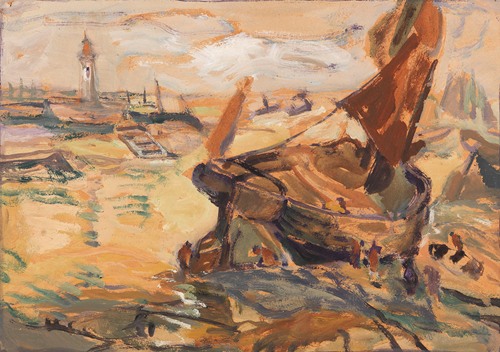
Born in Munich, Germany, Julius Seyler became a painter and teacher who spent most of his career in Germany but also spent time on the American frontier in the early 20th century. It was written that he "found his greatest satisfaction painting the Blackfoot Indians of Montana".
Seyler was a student at the Munich Academy of Fine Arts and there received classical training. In 1909, when he was age 36, he went to Paris to study and came under the influence of Barbizon painters including Jean Millet and Camille Corot. It is thought that his painting career would have continued in that tradition, except that he married Helga Boekmann, an art student from St. Paul, Minnesota. In 1910, he went to America with her to meet her family that included James J. Hill, the founder of the Great Northern Railway and one of the wealthiest men in the upper Midwest.
Returning to Paris, Seyler came under the modernist influences of Paul Cezanne and Vincent Van Gogh, and as a result, Seyler's painting became a composite of Impressionism, Expressionism and Realism.
When Seyler returned to St. Paul for the second time, he accompanied Louis Hill, Sr., the son of James J. Hill to Glacier Park where the Hill family was just beginning to promote the park as a stopping place for their railroad. With a program called "See America First", James J. Hill was hiring painters to create landscapes of Glacier Park, and Seyler did a number of those subjects. He loved the dramatic scenery and also became interested in the exotic and colorful costumes of the Indians and the concept of them living so freely on land that seemed boundless. He had plenty of opportunity for observation as he stayed at Glacier Park Lodge between the Blackfoot and Flathead Indian Reservations.
From 1914 to 1921, Seyler was in Balsam Lake, Wisconsin on a farm owned by his father-in-law because he could not return to Germany during the war. He had little time to paint because he did hard labor, but many times during that time he returned to Montana. In Germany in 1924, he became a Professor at the Munich Academy, and he continued his own painting career from his studio. However, in 1944, his studio and many of his paintings were destroyed in a World War II bombing. Four years later, his eyesight failed, and he had to give up painting, his passion in life. Seyler died in 1955 in his sleep at his home in Munich. His legacy was paintings of the American West executed with the sophistication of European modernist styles.


